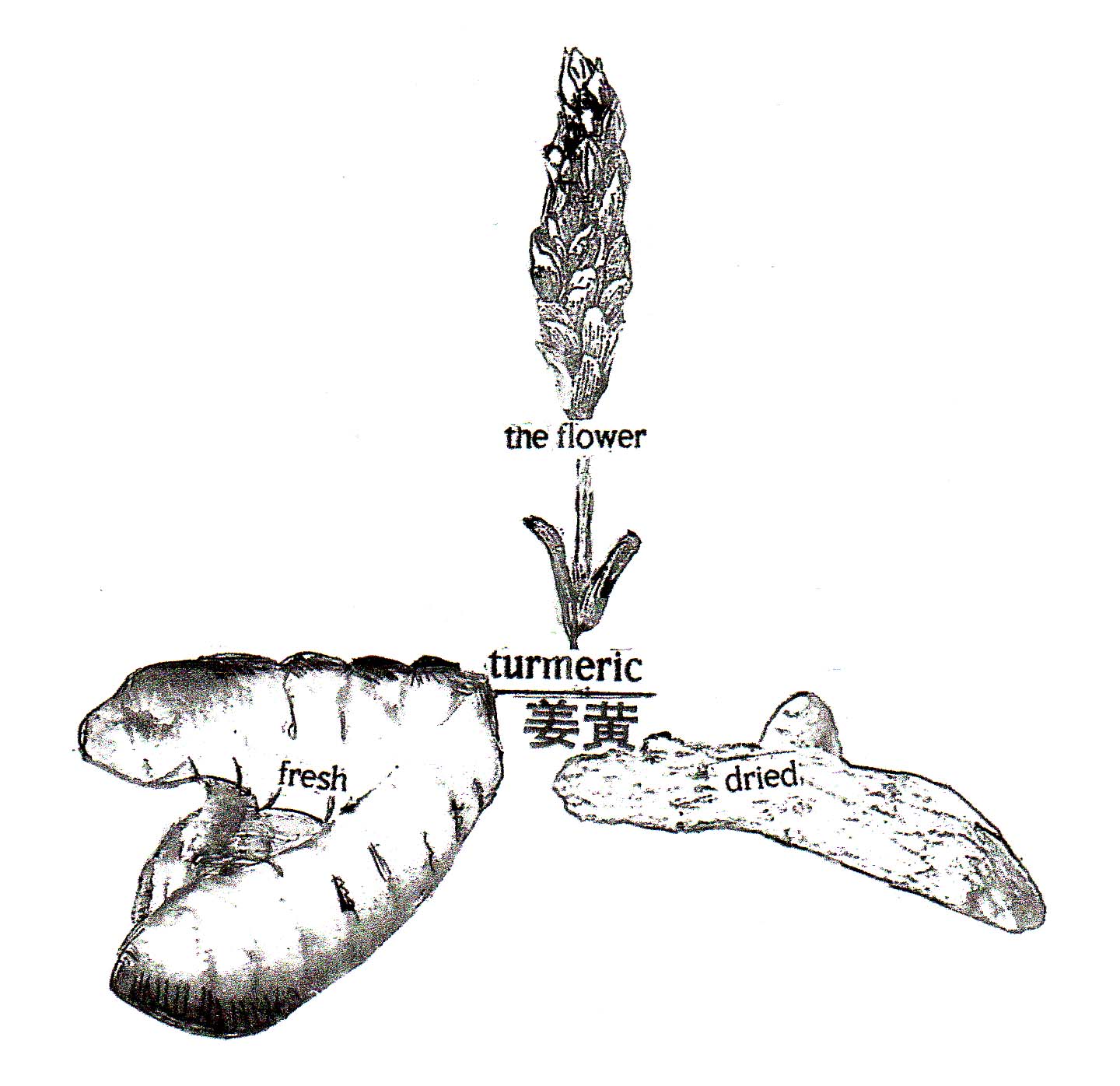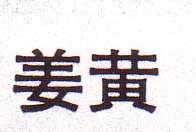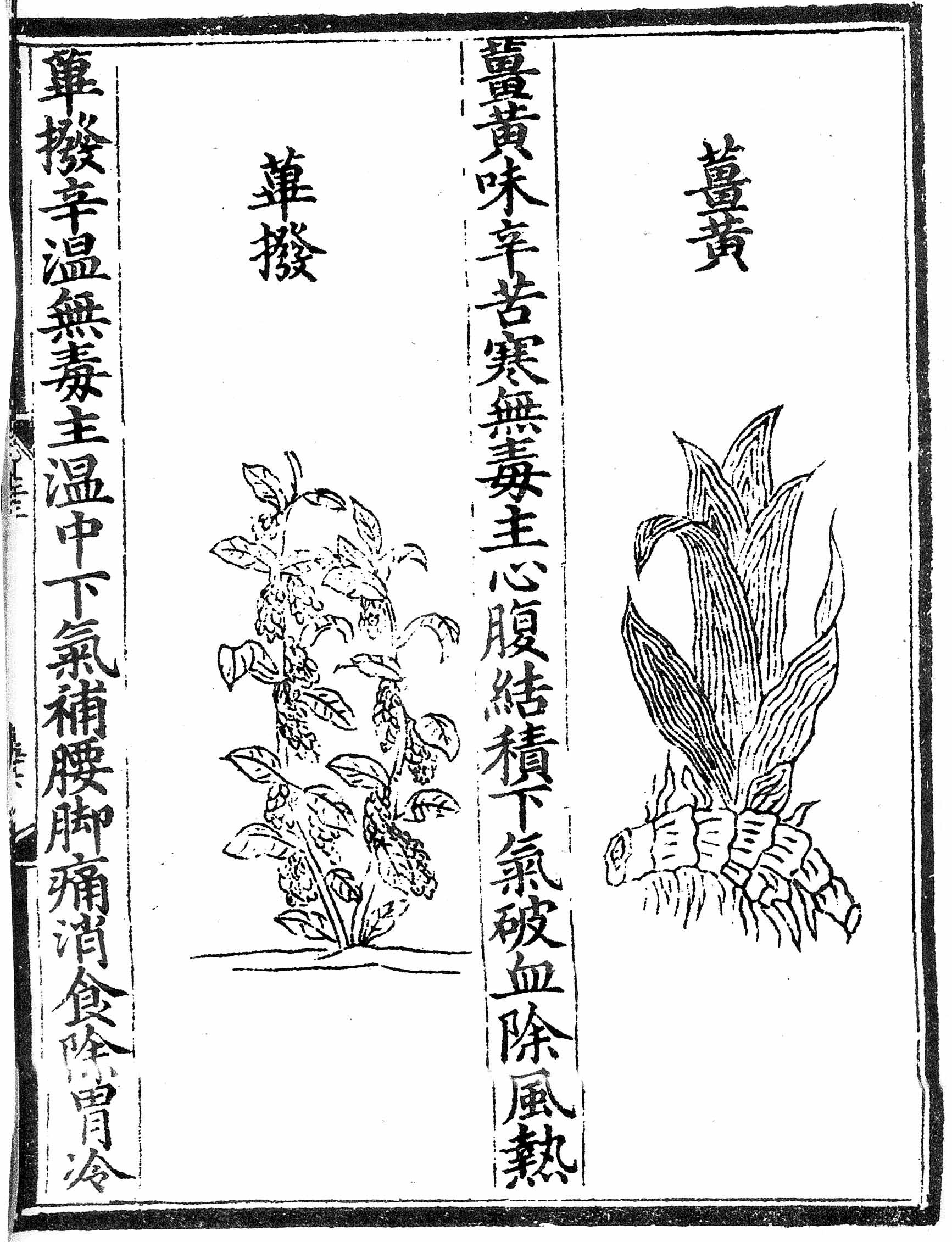
| What is Flavor and Fortune? |
| How do I subscribe? |
| How do I get past issues? |
| How do I advertise? |
| How do I contact the editor? |
Read 12726000 times
Connect me to:
| Home |
| Articles |
| Book reviews |
| Letters to the Editor |
| Newmans News and Notes |
| Recipes |
| Restaurant reviews |
| Article Index (all years, slow) |
| List of Article Years |
| Article Index (2025) |
| Article Index (last 2 years) |
| Things others say |
| Related Links |
| Log In... |
| Authors |
| Categories & Topics |
Turmeric: A Flavoring for Wine and Food
| by Jacqueline M. Newman |
Sauces, Seasonings, and Spices
Fall Volume: 2005 Issue: 12(3) page(s): 5, 21, and 32

 Turmeric, like so many other spices, was used in ancient China. It is not as popular now, nor is it in use in all regions of China. Its earliest recorded use was when mixing it with wine, and using that for ritual purposes. In China’s early days, only a minor amount was consumed in beverages or in foods. Curcuma aromatica and Curcuma longa, two of the more popular varieties, were used as medicinals. Later they became popular as flavorings for yogurt and vinegar.
Turmeric, like so many other spices, was used in ancient China. It is not as popular now, nor is it in use in all regions of China. Its earliest recorded use was when mixing it with wine, and using that for ritual purposes. In China’s early days, only a minor amount was consumed in beverages or in foods. Curcuma aromatica and Curcuma longa, two of the more popular varieties, were used as medicinals. Later they became popular as flavorings for yogurt and vinegar.
Researching this Islamic/Indian spice, probably grown in China for more than a thousand years, is a challenge. This food/medicine looks like a root but is a rhizome related to but not the same as ginger, even though they look somewhat alike.
It is not easy to learn its history for many reasons including that it came to China from both Persia and India. Another confusion is that the word turmeric is the name of an early deity. What is interesting, perhaps confusing, and maybe related, is that this god’s main purpose was to placate evil spirits using aromas to calm people. The Chinese-grown turmeric is highly aromatic and is greener than other Curcuma relatives grown in India, the East Indies, the Middle East, and elsewhere. This might raise the question as to which came first, the deity or the wafting of turmeric’s pleasant aroma?
‘Ginger yellow,’ is another name for the turmeric rhizome’s underground stem. It is the most aromatic part of the turmeric plant. It and stems and flowers are used in Chinese medicine and in its culinary; though no recipe was found for the flower. The name ‘ginger yellow’ comes from its looks as well as its color. Not only does the rhizome look a lot like ginger, the flower matches the part above ground, and the ability to color some foods and fabrics are similar.
 Historically, turmeric did become more than a ritual substance. It was used in cauldron-boiled foods along with cinnamon, fenugreek, saffron, black pepper, and roses. Later, in the Mongol era, a recipe called Balpo Soup became popular. It includes mutton, chickpeas, Chinese radish, black pepper, cardamon, coriander leaves, asafetida, salt, and turmeric. The earliest complete recipes we found were in the Soup of the Qan by Buell and Anderson (London: Kegan Paul International, 2000). The above illustration, from that book written by a diet doctor says turmeric: “supplements the center, and brings down qi...(and) extends the diaphragm.” It notes its use in several soups including Yellow Soup, Bear Soup, Fox Meat Soup, and Roast Wolf Soup, and in a dish called 'Turmeric Fish' where it and safflower, specifically mentioned as a dye, are used to give this dish color and flavor. Mentioned elsewhere, this important aromatic is discussed in pickling and in other dishes and as a dye, also as a cosmetic.
Historically, turmeric did become more than a ritual substance. It was used in cauldron-boiled foods along with cinnamon, fenugreek, saffron, black pepper, and roses. Later, in the Mongol era, a recipe called Balpo Soup became popular. It includes mutton, chickpeas, Chinese radish, black pepper, cardamon, coriander leaves, asafetida, salt, and turmeric. The earliest complete recipes we found were in the Soup of the Qan by Buell and Anderson (London: Kegan Paul International, 2000). The above illustration, from that book written by a diet doctor says turmeric: “supplements the center, and brings down qi...(and) extends the diaphragm.” It notes its use in several soups including Yellow Soup, Bear Soup, Fox Meat Soup, and Roast Wolf Soup, and in a dish called 'Turmeric Fish' where it and safflower, specifically mentioned as a dye, are used to give this dish color and flavor. Mentioned elsewhere, this important aromatic is discussed in pickling and in other dishes and as a dye, also as a cosmetic.
There are other confusions including one about turmeric as a color. It has been called saffron or Indian saffron even though there is no relationship between these two spices beyond their similarities of color and that both plants provide virtually identical hues. The name of the coloring agent in both of them is called 'curcumin.' It is a glycoside that gives off a well-known yellowish hue.
To add to all confusions, there are many varieties of turmeric, all having the ability to color things saffron-yellow. In China and other countries, the preferred use is to color the robes of its Buddhist monks. Secondarily, turmeric is used as a medicine. It is only after these important uses, that turmeric flavors foods. Perhaps this is because it has an acrid flavor. Among its popular medicinal uses listed in the literature are that turmeric is cooling, lacking poison, good to relieve stagnation accumulation of chest and abdomen, expels wind-heat, and that it destroys blood stasis.
Curcuma aromatica has been used the longest, centuries ago, and Curcuma longa became popular in the Tang Dynasty (618 - 907 CE). In China today, it is the more popular one. These two and other varieties are members of the family Zingiberaceae. Buddhists like its color, its taste; and its flavor. They add it to many dishes at their temples and use it in their homes. They like to preserve or pickle foods using turmeric; and they helped this spice became popular in common Chinese kitchens.
The fresh rhizome is dried and used in many stir-fries, in unheated foods such as in pickles, and hot or cold, it is mixed with other flavoring agents and spices. When ground and used alone, turmeric provides more color than flavor, unless used in large quantities. It is best heated then ground, and when fresh, its flowers and the underground stem are used together
At least since the Yuan Dynasty (1280- 1368 CE), and probably before, turmeric has been used in what are now called Manchurian dishes. These were and are popular in China’s north, and among the Chinese living in India. They are also popular with all who like Sichuan-style Chinese food. The Chinese call turmeric jiang huang, and they find a plethora of uses for it. Chinese traditional medicinal practitioners believe that it should be recommended for the control of diabetes. They say it also stimulates circulation, promotes the flow of qi, brings on the menses, relieves pain, and as a poultice, helps to heal bruises. In addition, they recommend it for rheumatic pain in the arms and shoulders, and think it valuable to reduce swelling caused by sudden trauma. Babies are given very small amounts of turmeric to reduce their colic. They suggest it to adults as treatment for pink eye, indigestion, and the relief of heavy coughs. Medical practitioners say everyone should take turmeric in small doses, no more than a teaspoon at a time, except when using it as an external poultice.
People in China’s north used to use more turmeric than those in the south even though this is a semi-tropical plant. Nowadys, it is gaining in popularity all over China. Below are a few recipes to illustrate turmeric’s use in cooked dishes, pickled vegetables and a pickled meat. There are none for use in wines or other beverages. We do hope that if a reader knows on one or more, they will send it to the editor who promises to share it.
| Beef Rolled with Mushrooms |
|---|
1/4 cup thinly sliced onion 3 Tablespoons sesame oil 2 Tablespoons oyster sauce 1 Tablespoon hoisin sauce 1 teaspoon ground turmeric 1 teaspoon sugar 5 very thin slices of beef, about three inches by nine inches; about a third of a pound 50 long thin light-colored enoki mushrooms 10 bamboo pith mushrooms, soaked for five minutes, thick ends removed, and slit open the long way Preparation: 1. Lightly brown onion slices in dry coated fry pan, then add the sesame oil and fry another one minute, remove and drain, reserving any oil. 2. Without removing any coating on the fry-pan, return onions to the pan, and add oyster sauce, hoisin sauce, turmeric, and sugar. Stir-fry for two minutes, stirring constantly, then set aside the onion mixture on a dish. 3. Lightly pound the meat, then cut each in half across the width. Put five mushrooms at one end of each slice of the beef, heads extending, and roll the meat, and set the rolls seam side down on the plate. 4. Put reserved oil in pan and heat the oil. The put each roll, seam side down, in the oil, and fry until brown, then turn and fry two minutes more before returning them to the seam-side down orientation. 5. Add the onion mixture on top of the rolls, cover, and simmer for five minutes, then serve. |
| Sweet and Sour Pickled Cabbage |
|---|
3 Tablespoons corn oil 1 Tablespoon sesame oil 4 cups washed and dried Napa cabbage, cut into one-inch wide pieces 4 red chili peppers, seeded and cut into very thin strips 2 Tablespoons thin or white soy sauce 1 Tablespoon Chinese black vinegar 1 Tablespoon Chinese red rice vinegar 2 Tablespoons sugar 1 teaspoon turmeric seeds 1 Tablespoon sesame oil Preparation: 1. Heat corn oil and the tablespoon of sesame oil in a wok or very large deep skillet. Then add cabbage and stir-fry for one minute. 2. Add chili pepper strips, soy sauce, both vinegars, sugar and turmeric seeds. Stir-fry for another two minutes, then drain and refrigerate for one to two hours. 3. Toss with sesame oil, put into a clean bowl, and serve. |
| Pickled Eggpant, Sichuan-style |
|---|
2 cups thin purple-skinned Japanese-style eggplant 1 cup white-skinned eggplant 1 cup green-skinned eggplant 1 teaspoon sesame oil 1/4 cup coarsely minced cilantro 1/2 teaspoon coarse salt 1 teaspoon sugar 4 Tablespoons clear rice vinegar 2 Tablespoon red rice vinegar 2 Tablespoons thin or white soy sauce 2 Tablespoons finely minced fresh ginger 2 Tablespoons finely minced fresh garlic 1 Tablespoon whole turmeric seeds, smashed with wooden handle of a cleaver 3 fresh red chili peppers, seeded, and minced 1 Tablespoon toasted sesame seeds, as garnish Preparation: 1. Wash, dry, then cut all the eggplants in half-inch by two-inch strips. Then line steamer basket with an all-white paper towel and place then on it. 2. Steam over boiling water for twenty minutes, remove to a strainer basket, and cool in the refrigerator, covered for one hour. 3. Mix rest of the ingredients, except the sesame seeds, in a glass or other non-reactive bowl, then toss with the eggplant pieces. Cover and set aside for one hour. Then drain and sprinkle on sesame seeds and serve. |
| Pickled Duck Tongues |
|---|
1 pound duck tongues 2 whole star anise 1/2 black cardamon, husked and smashed with cleaver handle 1 teaspoon turmeric seeds, smashed with cleaver handle 1 teaspoon Sichuan peppercorns, smashed with cleaver handle 2-inch piece tangerine peel, soaked for ten minutes, then minced 1 teaspoon sugar 1 Tablespoon thin soy sauce 1 Tablespoon Chinese black vinegar 3 Tablespoons Chinese white rice vinegar 2 Tablespoons sesame oil Preparation: 1. Bring two quarts water to the boil, add duck tongues, reduce heat, and simmer for ten minutes, reserving and straining one cup of the liquid. Rinse them under cold water, and remove both soft bone in front of the tongue and the firm bone in the back, and put them into a glass or other non-reactive bowl. 2. Reheat cup of strained liquid, add four spices, tangerine peel, and sugar and bring to the boil, then reduce heat and add sou sauce and vinegars and simmer two minutes longer, before removing from the heat. Allow to cool for half an hour then pour over the duck tongues. 3. Cover the bowl and refrigerate overnight or up to twelve hours, remove from the refrigerator, drain well, put into a serving bowl, toss with the sesame oil, and serve. |
| Cauliflower, Manchurian |
|---|
3 cups fresh cauliflower, cut into one to two inch tree-like pieces 1 egg, beaten well 1/4 cup flour or water chestnut flour, or a mixture of both 1 Tablespoon chili paste with garlic 1 teaspoon black bean paste with garlic 3 cups oil 3 slices fresh ginger, minced 1 green chili, seeded and minced 1/2 large green pepper, cut into one-inch pieces 1/2 large sweet red pepper, cut into one-inch pieces 1 Tablespoon soy sauce 1/4 teaspoon salt and white pepper, mixed 1/4 teaspoon ground turmeric 1 Tablespoon minced fresh coriander Preparation: 1. Mix cauliflower pieces, beaten egg, flour, and two tablespoons water. 2. Heat oil, remove about half the cauliflower pieces from the flour batter, allow some draining, then deep fry them until very light brown. Drain and set them on paper towels. Repeat with the rest of the cauliflower. Set aside the oil for this and other uses, after straining it. 3. Mix all the remaining ingredients. Heat one tablespoon of the remaining oil, and fry this mixture for one minute, then add cauliflower, stir well, and remove all to a bowl and serve. |

Copyright © 1994-2025 by ISACC, all rights reserved
Address
3 Jefferson Ferry Drive
S. Setauket NY 11720